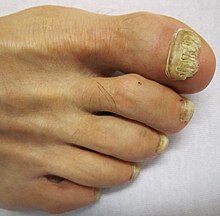
The nail is the body's most important asset, and is important to you too. They add to your general attractiveness, besides alerting you when something is wrong inside your body. When they turn brown or darker in color, it's a sign that you need to visit your doctor for some advice. Well, if you are obsessed with your nails, you will naturally want to take care of them and even the slightest sign of nail damage is enough to get you worrying.
Nail fungus is one of the most common nail ailments we've seen so far. Also known as onychomycosis, this fungal infection burrows deep beneath your nails, and if left untreated, will cause your nails to look crusty, thick or distorted. Actually, the condition could turn out to be an embarrassing one if it persists.
What are the symptoms of nail fungus?
The symptoms of nail fungus are quite obvious, because they are visible early enough. You'll see the tip of your nail developing a white or yellow patch. Over time, this patch thickens and eventually distorts the shape of your nail as time goes by.
Fungi are capable of spreading really quickly, so they grow underneath and into your nails causing discoloration, crusting and darkening of the affected nail. Then the affected nail begins to separate from the nail bed. It is at this stage that you may begin to experience some pain as well as some foul odor around the tip of your fingers and toes.
Who gets toe-nail fungus?
Statistically, nail fungus infections are common among men than women, and is also common with the elderly than the young. Other factors that may put one at risk of catching this infection include the following:
1. Slow growing nails
2. Heavy perspiration
3. Humid and moist environmental conditions
4. Shoes and socks without ventilation
5. Walking bear-footed in damp places
6. Previous injury on the nail
7. Weakened immune system
8. Poor blood circulation
What causes nail fungus?
This infection is cause by microscopic organisms known as fungi which don't require sunlight in order to survive. A group of fungi known as dermatophytes are responsible for causing this nail infection. Furthermore, some type of yeast and molds can also cause this nail infection.
''Trichophyton rubrum'' is the most common type of dermatophytes responsible for nail infection. However, common mold causes of this infection may include scopulariopsis, neoscytalidium and aspergillus. These pathogens usually gain access into the skin through small cuts around the nails or through small separations between the nail bed and the actual nail. Now, when the nail provides an ideal environment, the fungi grow.
What are the natural treatments available?
Treating this nail condition can be a long-term and expensive process as well. Patients can use oral anti-fungal medication to treat this condition, but again these may come with plenty of side effects which you are not ready to deal with. Prolonged use of these drugs may cause skin rashes or liver damage. Therefore, the safest way to go about treating toe-nail fungus infection is through using natural means.
Tea tree oil is a natural disinfectant which can be found in most health food stores. Now, this requires patience because tea tree oil doesn't work overnight to bring results the next day. Once you have it, paint the affected nail twice a day for at least 2 months. It's a long term treatment, so you have to wait until the nail grows out in order for the fungus to die out.
Another alternative home remedy you could use is grapefruit seed extract. Use it the same way you use tea tree extract. Paint the affected nail twice a day for at least 2 months. Garlic also has anti-fungal properties, but you have to consume it raw in order to see long term results.
Some patients go for oral medication when they are not the safest. Even though side effects are not too common with these drugs, there's no need to take risks when there are proven natural remedies that can treat the condition.
While you treat this nail fungal infection, ensure that you keep your toenails dry at all times. Wearing open shoes is most welcomed due to ventilation purposes. Keep your fit as clean as possible, and remember that moisture is your worst enemy.
Author Bio:
Jazzi George is a Team Member at MoleRemoval.net She loves to write about health problems, Beauty tips, and various issues related to skin.

No comments:
Post a Comment
I love feedback, Please speak your mind. Spam comments will not be Published or will be deleted immediately, thanks.